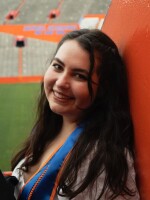Millions of people looked up to the skies today to catch a glimpse of the moon passing in between the earth and the sun.
The solar eclipse swept across North America and with it a frenzy of spectators. The path of totality was expected to stretch from Mexico to Texas to Maine and into Canada. In South Florida, we were only due to get a partial view of the eclipse that began around 1:47 p.m. EST and reached its peak max at 3:03 p.m.
READ MORE: Teens get up-close and personal with wild sharks to encourage careers in science
Crowds rushed to put on their ISO certified glasses as they line up in front of the Frost Museum's Celestron telescope in downtown Miami.
The celestial event drew curious children like 8-year-old twins Bernardo and Franco Canedo. It's their first eclipse. Franco said he was a little frightened because he doesn't know how the moon is going to cover the sun.
Their mom, Gabriela Canedo, said she wants her boys to make a lasting memory.
"We're excited because it's their first eclipse. I still remember the only eclipse I saw as a little girl," she said in Spanish. "So I want them to have this same experience because I know they'll never forget it."
The last solar eclipse took place in August 2017. According to NASA, the 2024 eclipse was set to have a wider path and pass more densely populated areas.
The auspicious day was the backdrop of a date between Daniel Zamora and Rosa Rodriguez. Zamora, who saw a total eclipse as a kid in Venezuela in 1998, wanted to catch the full eclipse again but was happy to have made it to Frost nonetheless.
"I was looking for flights all over the place but it was last minute. I had to plan a little bit better because I would've liked to have seen the total eclipse,” Zamora said.
"It's a sweet date because I've never been to the museum before. So my first eclipse coincides with my first time at the museum, so I'm having a lot of fun," Rodriguez said.
An opportunity to learn
Snowbirds, residents and families alike gathered outside of the Key Largo Branch Library for a solar eclipse watch party. Well over 100 people showed up for the event, as it was one of the last spots around town with glasses to give out.
Cary Reyes, a Key Largo Branch library assistant, organized the event. The library only had 55 pairs of glasses available for people who showed up, and Reyes wanted to prioritize families with young kids.
Reyes hoped the free watch party would prove to be an educational experience for people of all ages.
“We support education at any level and we embrace all community members to be a part of it,” Reyes said.
The consolation prize for those who couldn’t get a pair: a sweet treat. Reyes and library staff prepared mini donuts stuffed with Oreo cookies and cream to simulate the corona of the sun and the dark space of the moon moving in front of it.
Jessica Frybarger brought her three kids, Gennaro, Florence and Alice. She said she recalled making eclipse viewers out of shoeboxes with her mom the first time she ever saw a solar eclipse and was excited to get to have a similar experience with her children.
With mostly cloudless skies over Key Largo, the eclipse was only partially visible from the Upper Keys. Each kid filled out viewing sheets prepared by the library where they got to draw what the eclipse looked like at different times.
Around 2 p.m., 5-year-old Alice told WLRN her scientific observation: “It looks like a little mouse bit it!”
Getting a good view
In Palm Beach County sky gazers had access to South Florida's largest public telescope at The Cox Science Center in West Palm Beach.
Marc Wiskoff, a senior technical advisor for the Marmot Observatory, said their $60,000 reflector telescope took 18 months to build.
The team designed a camera “that fit inside the lens, and that camera had its own Wi Fi signal. And it projected whatever the scope saw on our monitors," Wiskoff said.
The technology allows for the Science Center to stream such celestial events and share them on their own YouTube and Zoom channels.
Fouad Khan, a clinical partner with Great Expressions Dental Centers, wanted to savor this moment with his youngest child, 11-year-old Ammar Khan.
"There's a human connection, there's a universal connection, right? The next event that's gonna happen is not for another 20 years. So I don't know if I'll be around to watch that one," Khan said. "So I wanted to make sure that I get out and actually, you know, spend some time with him and be able to be a part of the solar eclipse party."
It's his first time at the Cox. Khan moved to Florida about a year and a half ago from Michigan. Ammar Khan, a shy 11-year-old, was celebrating his birthday at the Cox during the solar eclipse watch party.
"It's on my birthday, and it's the first one that I'm going to be able to see," he said.
Wiskoff said the next solar eclipse is in 2026, "starting around Iceland, Greenland, Iceland, through the Atlantic, through Spain and finishing up in the Atlantic."
The next one in our area will be in 2044 — 20 years from now. He said this once in a generation experience is what makes it such a huge significance for the community and the solar event "humbles us as humans."
"It shows how insignificant we are in the scheme of things," Wiskoff said. And we come together during disasters. Wonderful. But you don't want to wait for a disaster. You want to wait for something amazing to happen."
*WLRN Intern Anita Li and the Associated Press contributed to this report



























